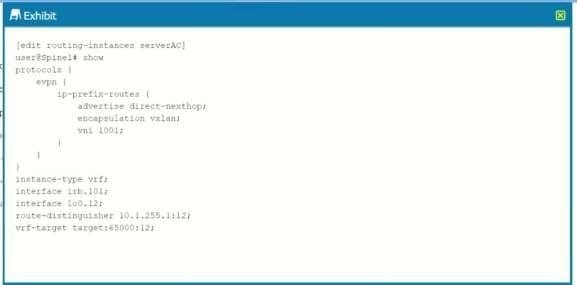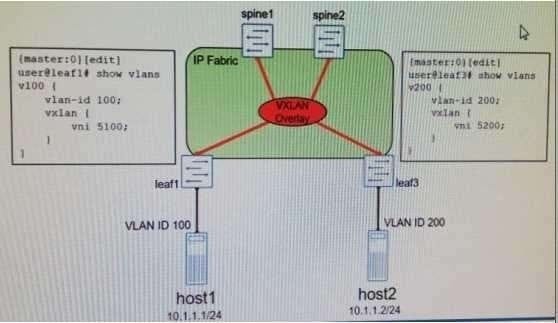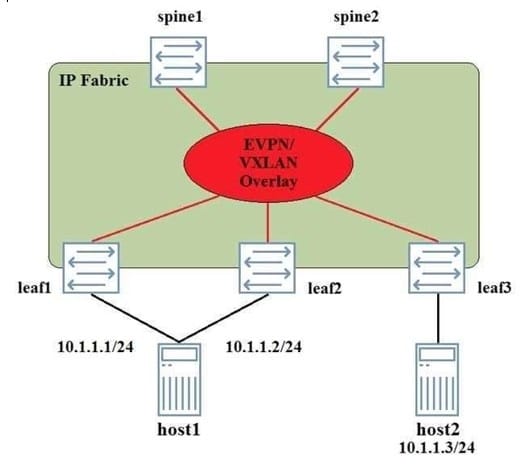JN0-682 Online Practice Questions and Answers
Questions 4
You are building an IP fabric underlay for your data center. You are asked to ensure that the two spine devices are in the same AS (65000) while the six leaf devices are in a different AS (65512). In this scenario, which two statements are correct by default? (Choose two.)
A. All BGP routes advertised by a leaf device will be accepted on the spine devices.
B. A leaf device will accept all BGP routes received from the spine that were originated from another leaf device.
C. All BGP routes advertised by a leaf device will be rejected on the spine devices.
D. A leaf device will reject all BGP routes received from the spine that were originated from another leaf device.
Questions 5
You are deploying an EBGP IP fabric. In this scenario, which statement is true?
A. Each spine should peer with every other spine using physical addresses.
B. Each spine should peer with each leaf using loopback addresses.
C. Each spine should peer with every other spine using loopback addresses.
D. Each spine should peer with each leaf using physical addresses.
Questions 6
You are asked to deploy an Ethernet bridging design in a data center with the criteria shown below.
-Routing must occur on the spine devices.
-VTEPs must terminate on the leaf devices.
-Facilitate inter-VLAN communication.
-Layer 2 gateways must be present on spine and leaf devices.
Which architecture should you use in this scenario?
A. edge-routed bridging architecture
B. centrally-routed bridging architecture
C. bridge overlay architecture
D. collapsed spine architecture
Questions 7
Referring to the exhibit, you must advertise the Io0.12 interface as a type-5 route.
Which configuration parameter would be used to accomplish this task?

A. Configure auto-export under the routing instance.
B. Configure a vrf-export policy to advertise the interface route under the routing instance.
C. Configure an export policy to advertise the interface route under protocols evpn.
D. Configure vrf-table-label under the routing instance.
Questions 8
Devices spine1 and spine have been configured as distributed Layer 3 gateways in the VXLAN topology, and devices leaf1 and leaf3 have been configured as layer 2 gateways. Device host must be able to communicate with device host?

Which two statements are true? (Choose two.)
A. An IRB interface must be configured on device leaf1 and leaf2.
B. An IRB interface must be configured on devices spine1 and spine2.
C. Traffic from host1 to host2 will transmit the VXLAN tunnel from leaf1 to leaf3.
D. Traffic from host1 to host will transit a VXLAN tunnel to spine or spine2 then a VXLAN from spine1 or spine2 to leaf 3.
Questions 9
You host a multitenant data center that runs VMware. You must perform deep packet inspection on all inter-tenant traffic that is flowing between the VMs within the same hypervisor. Your solution must provide the security services without needing to leave the physical device. In this scenario, what should you do to solve this problem?
A. Use separate vswitches to isolate each-tenant's network and use and use a vSRX device to evaluate inter-tenant traffic.
B. Use VLANs to isolate each tenant's networks and use an SRX Series device to evaluate inter-tenant traffic.
C. Use a VLANs to isolate each tenant's network and use IP tables to evaluates inter- tenant traffic.
D. Use a vMX device to isolate each tenant's network and use firewall filters to evaluate inter-tenant traffic.
Questions 10
What happens when a packet is encapsulated by a VXLAN before being placed in the overlay?
A. The TTL is decremented by two and placed in the VXLAN header.
B. The QoS marketing are placed in the VXLAN header.
C. The VLAN-ID is placed in the VXLAN header.
D. A VNI that maps to the VLAN-ID placed in the VXLAN header.
Questions 11
An EVPN-signaled VXLAN overlay has been deployed in the network shown in the exhibit.
Host1 is a bare metal server, and is dual-homed to the network. The IP addresses 10.1.1.1/24 and 10.1.1.2/24 are assigned to the same physical NIC, and no virtualization is configured on the server.

In this scenario, which two statements are true? (Choose two.)
A. The MAC address associated with 10.1.1.1/24 and 10.1.1.2/24 will be same when advertised to leaf3.
B. Traffic from IP address 10.1.1.1/24 must traverse the VXLAN network to reach IP address 10.1.1.2/24
C. The connection host1 to devices leaf1 and leaf2 must be configuration a LAG.
D. The ESI assigned to the host1 link must be the as the ESI assigned to the leaf2 host1 link.
Questions 12
A VXLAN has been created between devices leaf1 and Ieaf3.

Referring to the exhibit, which statement is true?
A. Traffic sent from host1 to host2 will be dropped on Ieaf3.
B. Traffic sent from host1 to host2 will be tagged with VLAN ID 100 when exiting Ieaf3.
C. Traffic sent from host1 to host2 will be tagged with VLAN ID 200 when exiting Ieaf3.
D. Traffic sent from host1 to host2 will be dropped on leaf1.
Questions 13
What are three advantages of using MPLS for data center interconnects? (Choose two.)
A. Dedicated MPLS backbones for Layer 1 and Layer 3 DCIs
B. Any to any connectivity
C. Dedicated connections between customer sites
D. Sub 50 ms failover times
E. Traffic engineering
